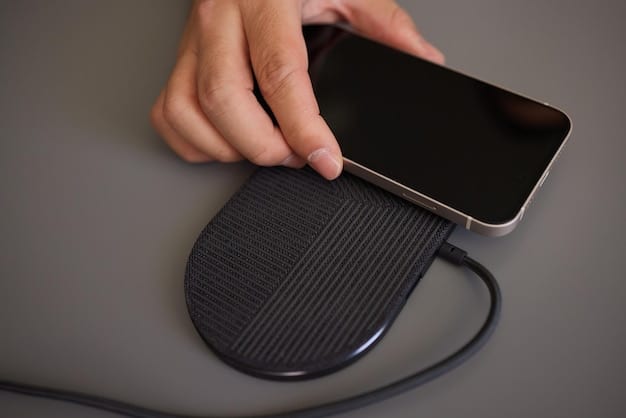The Latest Advances in Wireless Charging Technology: A 2025 Update

The Latest Innovations in Wireless Charging Technology: A 2025 Update explores the groundbreaking advancements reshaping how we power our devices, from extended ranges and faster charging speeds to enhanced safety protocols and integration with smart ecosystems.
Step into the future of power with The Latest Innovations in Wireless Charging Technology: A 2025 Update. Discover how wireless charging is evolving to become faster, safer, and more integrated into our everyday lives, transforming how we think about energy and device management.
Understanding the Current Wireless Charging Landscape
Wireless charging has moved beyond a novelty and is now a practical solution for many consumers. In 2025, understanding its current capabilities sets the stage for appreciating the innovations on the horizon.
What exactly defines the current scope of wireless charging?
Qi Standard Dominance
The Qi standard remains the dominant force in wireless charging, supporting a wide range of devices from smartphones to earbuds. Its widespread adoption ensures compatibility across different brands and devices.
Charging Speeds and Efficiencies
Current wireless charging speeds, while convenient, often lag behind wired charging. Efficiencies are also a point of focus, as energy loss during wireless transfer remains a challenge. Advancements are continually being made to close this gap.

The wireless charging landscape is constantly evolving. These points highlight where we are now and where the future is heading with the latest technological innovations.
- Ubiquitous Compatibility: Qi standard ensures cross-brand compatibility.
- Speed Limitations: Wireless charging is still slower than wired.
- Efficiency Focus: Reducing energy loss is a key priority.
The push for more efficient and faster wireless charging solutions continues to drive progress within the industry.
Long-Range Wireless Charging: A Game Changer
One of the most anticipated innovations is long-range wireless charging. This technology promises to eliminate the need for direct contact with charging pads, offering unparalleled convenience.
How does long-range wireless charging work, and what are its potential benefits?
How it Works
Long-range wireless charging uses radio frequencies or focused ultrasound to transmit power over a distance. This allows devices to charge without being placed on a pad or plugged into a wall.
Real-World Applications
Imagine entering a room and your phone automatically starts charging—that’s the promise of long-range wireless charging. This technology could revolutionize how we power devices in homes, offices, and public spaces.

The implications of long-range wireless charging are profound. Its potential to simplify our charging routines and create more seamless experiences is attracting significant attention.
- Radio Frequency: Uses radio waves to transmit power.
- Focused Ultrasound: An alternative method for power transmission.
- Seamless Charging: Devices charge automatically in designated areas.
Long-range wireless charging is poised to transform our understanding of how we power and interact with our devices.
Enhanced Charging Speeds and Efficiency
Speed and efficiency are critical factors in the evolution of wireless charging. The latest innovations are focusing on optimizing these aspects to provide a more competitive alternative to wired charging.
What advancements are being made in charging speeds and efficiency?
New Materials and Designs
Researchers are exploring new materials and coil designs to minimize energy loss and increase charging speeds. Advanced materials can improve heat dissipation and conductivity, leading to more efficient energy transfer.
Software Optimization
Software plays a crucial role in managing the charging process. Intelligent algorithms can optimize power delivery, preventing overheating and maximizing efficiency. Software updates can also improve compatibility with new devices.
These improvements aim at making wireless charging a faster, more reliable option for consumers.
- Advanced Materials: Improve conductivity and reduce heat.
- Coil Design: Optimized designs enhance energy transfer.
- Intelligent Algorithms: Optimize power delivery and prevent overheating.
The combination of hardware and software innovations promises to significantly boost the appeal of wireless charging technology.
Integration with Smart Home and IoT Devices
As smart homes and IoT devices become more prevalent, wireless charging is being integrated into these ecosystems. This integration provides seamless and convenient power solutions for a wide range of devices.
How is wireless charging being integrated into smart home environments?
Embedded Charging Surfaces
Wireless charging technology is being embedded into furniture, countertops, and other surfaces. This allows for discreet and convenient charging of devices without the need for visible charging pads or cables.
Smart Charging Hubs
Smart charging hubs can manage power distribution to multiple devices simultaneously. These hubs can prioritize charging based on device usage and battery levels, optimizing energy consumption.
The integration with smart home and IoT devices enhances convenience and simplifies device management.
- Embedded Surfaces: Charging built into furniture and countertops.
- Smart Hubs: Manage power to multiple devices efficiently.
- Automated Prioritization: Optimizes energy consumption based on device needs.
The seamless integration of wireless charging into smart environments is setting the stage for a more connected and convenient future.
Safety and Security Enhancements
Safety and security are paramount in the development of wireless charging technologies. Ensuring devices are protected from overheating, overcharging, and potential security breaches is critical.
What measures are being taken to enhance safety and security?
Temperature Monitoring
Advanced temperature monitoring systems can detect overheating and automatically adjust or halt charging to prevent damage. Sensors can track temperature in real-time, ensuring safe operation.
Encryption and Authentication
Wireless charging systems are incorporating encryption and authentication protocols to prevent unauthorized access and potential security breaches. This protects devices from malicious attacks and ensures secure power transfer.
These enhancements are fostering trust and confidence in wireless charging technologies.
- Temperature Sensors: Monitor and prevent overheating.
- Encryption Protocols: Protect against unauthorized access.
- Authentication Measures: Ensure secure power transfer.
Prioritizing safety and security is essential for the continued adoption and advancement of wireless charging.
Future Trends and Predictions
Looking ahead, several trends and predictions are shaping the future of wireless charging technology. These advancements promise to further revolutionize how we power our devices and interact with energy.
What are some of the key trends and predictions for the future?
Increased Standardization
Efforts to standardize wireless charging protocols will continue, ensuring greater compatibility across different devices and brands. A unified standard will simplify the user experience and promote widespread adoption.
Dynamic Charging
Dynamic charging, where devices charge while in motion, is gaining traction. This technology could enable electric vehicles to charge while driving on highways, extending their range and reducing the need for frequent stops.
The future of wireless charging is bright, with ongoing research and development paving the way for innovative solutions.
- Unified Standards: Greater compatibility across devices.
- Dynamic Charging: Charging while in motion.
- Advanced Applications: Wireless power for electric vehicles and more.
These trends and predictions highlight the transformative potential of wireless charging technology in the years to come.
| Key Point | Brief Description |
|---|---|
| 💡 Long-Range Charging | Power devices without direct contact to charging pads. |
| ⚡ Charging Speeds | Advancements in materials and software for faster rates. |
| 🏡 Smart Home Integration | Embedded charging in furniture and smart power hubs. |
| 🛡️ Safety Measures | Monitoring temperature and encryption for protection. |
Frequently Asked Questions
Long-range wireless charging uses technologies like radio frequencies or focused ultrasound to transmit power, allowing devices to charge without direct contact with a charging pad.
By 2025, advancements in materials and software optimization are expected to significantly boost wireless charging speeds, making it a more competitive alternative to wired charging.
Yes, with the development of long-range charging, public places may integrate charging zones where your device charges automatically, leading to more access points for use.
Security is a priority; wireless charging incorporates encryption and authentication protocols to prevent unauthorized access, ensuring safe and secure power transfer to your devices.
Wireless charging stations can be powered by renewable energy sources like solar, potentially reducing the carbon footprint of charging devices and advancing sustainable practices.
Conclusion
The landscape of wireless charging is rapidly evolving, promising a future where power is delivered seamlessly and efficiently. As we approach 2025, these advancements are poised to transform how we interact with our devices, creating more convenient, connected, and sustainable experiences.





